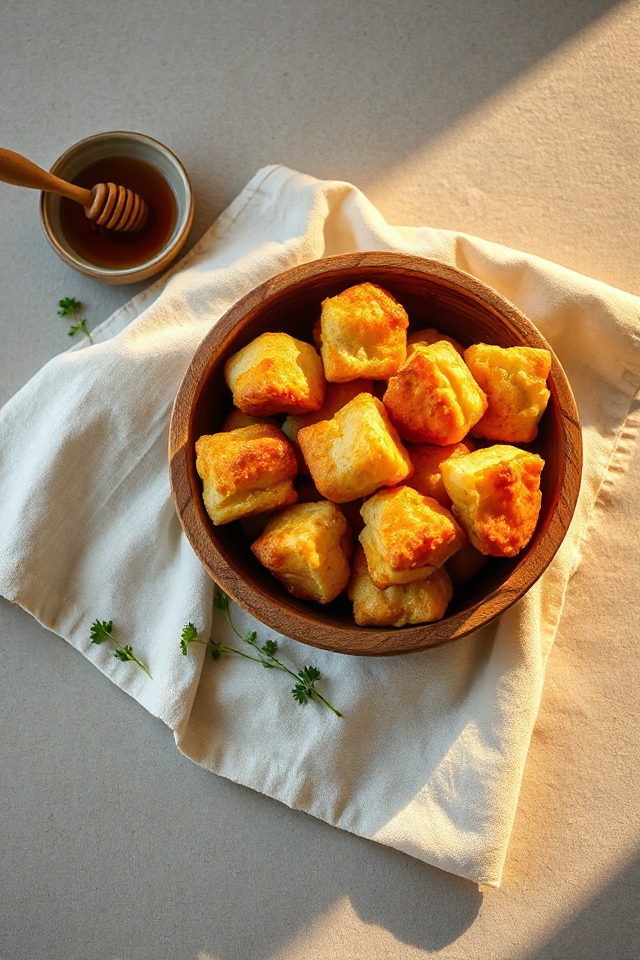Why You’ll Love This Fried Bread Recipe
If you’re looking for a delicious treat that’s quick to make, you’ll absolutely love this fried bread recipe. It’s incredibly simple and requires minimal ingredients, so you won’t spend hours in the kitchen.
I adore how the dough transforms into golden, fluffy bites that are perfect for snacking or pairing with savory dishes. The aroma of frying bread fills my home, creating an inviting atmosphere that brings everyone to the kitchen.
Each piece is crispy on the outside and soft on the inside, making it hard to resist. Trust me, once you try it, you’ll keep coming back for more!
Ingredients of Fried Bread
When it comes to making fried bread, the ingredients are simple but essential to creating those fluffy, golden bites we all crave. You won’t need a fancy pantry to whip this up—just a few staples and you’re on your way to a delicious treat.
It’s like a hug in bread form, and who doesn’t want that? Let’s explore what you’ll need to gather before you start frying up this heavenly goodness.
Ingredients for Fried Bread:
- 2 cups all-purpose flour
- 1 1/2 teaspoons baking powder
- 1/2 teaspoon salt
- 1/4 teaspoon baking soda
- 1 1/3 cups buttermilk (approximately)
- Oil (for deep frying)
Now, let’s chat about these ingredients for a moment. First off, all-purpose flour is your best friend here—it gives the bread that perfect structure and chew.
Baking powder and baking soda work together to help the dough rise and achieve that fluffy interior. Salt adds flavor, and trust me, you don’t want to skip it.
Oh, and the buttermilk? It’s the secret ingredient that keeps things moist and adds a slight tang, which is just delightful. If you’re out of buttermilk, no worries! You can easily make your own by mixing milk with a splash of vinegar or lemon juice. Just let it sit for a few minutes, and voilà, homemade buttermilk!
And then, of course, you need oil for frying; I recommend something neutral like vegetable or canola oil to keep the focus on that delectable bread.
How to Make Fried Bread

Alright, let’s plunge into how to make that oh-so-delicious fried bread. First things first, grab a large bowl and sift together 2 cups of all-purpose flour, 1 1/2 teaspoons of baking powder, 1/2 teaspoon of salt, and 1/4 teaspoon of baking soda. Sifting is key here; it’s like giving your dry ingredients a little spa day, making them light and airy.
Just picture it: the flour is relaxing, the baking powder is sunbathing, and the salt is getting a nice exfoliation. Once that’s done, it’s time to bring in the buttermilk. Slowly pour in about 1 1/3 cups of buttermilk while stirring constantly. Now, don’t be afraid to add a bit more buttermilk if your dough feels too dry. You want it to be soft but not sticky—think of it like a gentle hug rather than a clingy friend.
Once you’ve got that dough just right, turn it out onto a lightly floured surface and knead it a few times. Don’t go overboard; we’re not trying to make a workout out of this. Just enough to bring everything together.
Now, roll it out or use your hands to pat it down to about 1/2 inch thick. Here’s where you can let your creativity shine—cut it into 3-inch rounds or get fancy with diamond shapes. Whatever floats your boat.
Now for the fun part: deep frying. Heat up some oil (I recommend vegetable or canola for a neutral flavor) in a deep pot. When it’s hot—like, really hot—drop in your bread pieces. Fry them for about 5 to 6 minutes until they turn a beautiful golden brown.
It’s like watching magic happen in front of your eyes. And just like that, you’ve got yourself some fluffy, golden fried bread that’s ready to be devoured. Just try not to eat them all at once; I know it’s tempting.
Fried Bread Substitutions & Variations
While fried bread is delightful as is, exploring substitutions and variations can elevate your culinary experience.
For a gluten-free option, I’ve used almond flour or a gluten-free blend, which works surprisingly well. If you’re craving something sweet, adding a touch of sugar or cinnamon to the dough can make a tasty twist.
For savory flavors, try incorporating herbs like rosemary or garlic powder. I’ve also experimented with different liquids; yogurt or coconut milk can create a unique texture.
Finally, shape your fried bread into triangles or larger rounds for fun presentations. The possibilities are endless! Enjoy experimenting!
Additional Tips & Notes
Exploring substitutions and variations can enhance your fried bread experience, but there are a few additional tips that can guarantee your success.
First, make sure your oil is hot enough; if it’s not, your bread will absorb too much oil. I always test with a small piece of dough before frying the whole batch.
Also, don’t overcrowd the pan; fry in batches for even cooking. If you want a crispier texture, let the fried bread drain on paper towels.
Finally, serve it fresh for the best flavor. Enjoy experimenting with toppings—honey or jam are personal favorites of mine!
